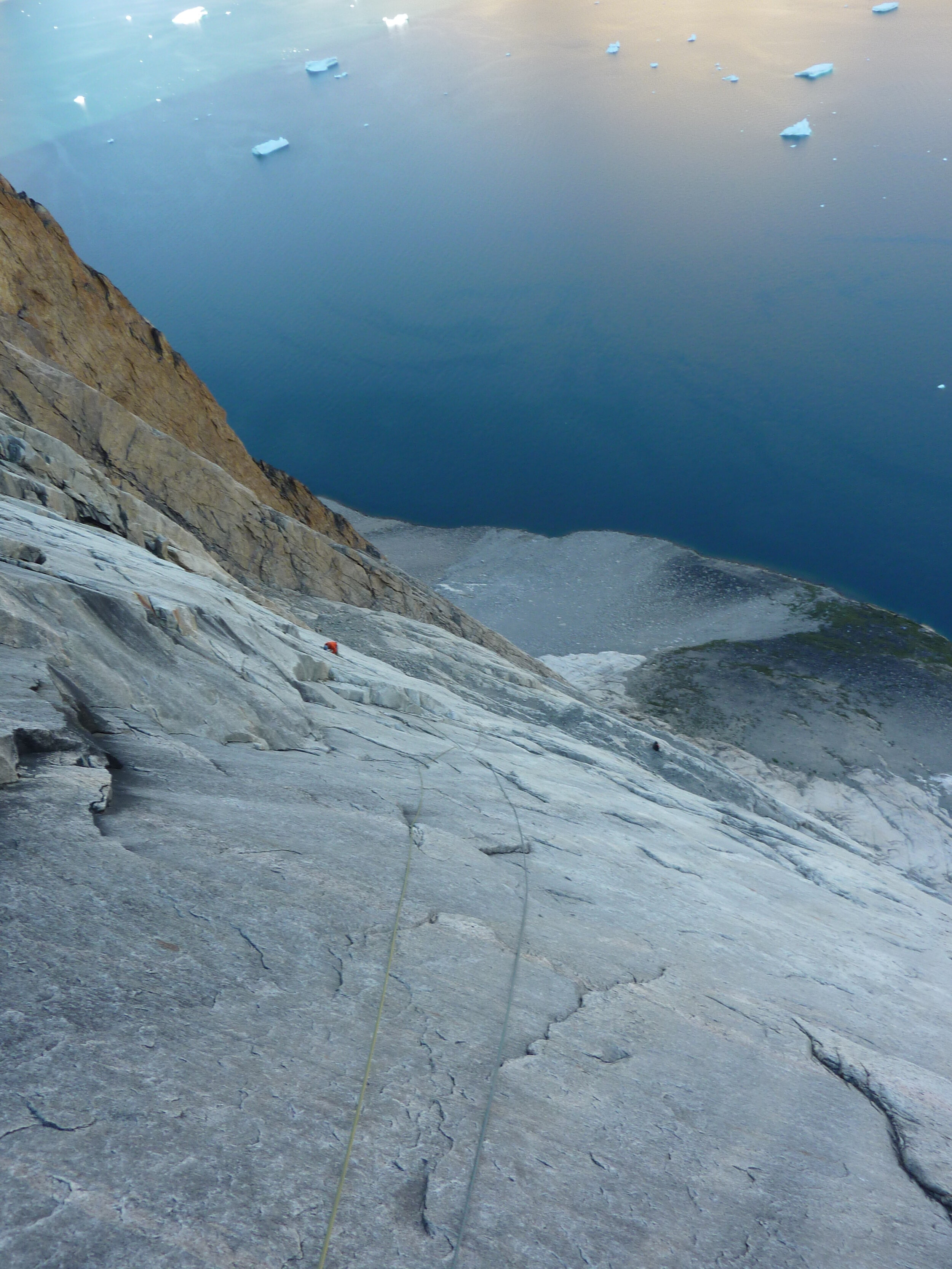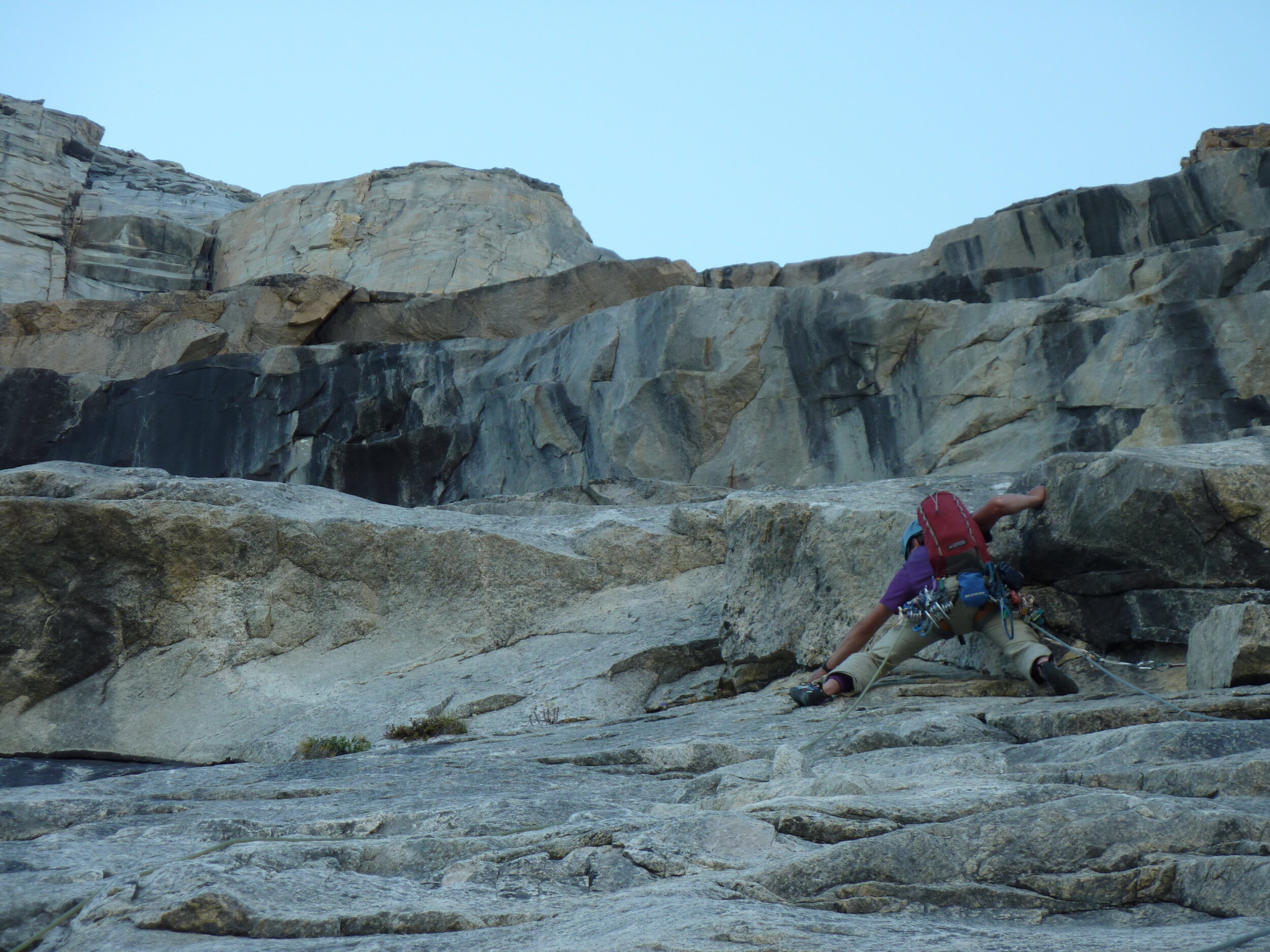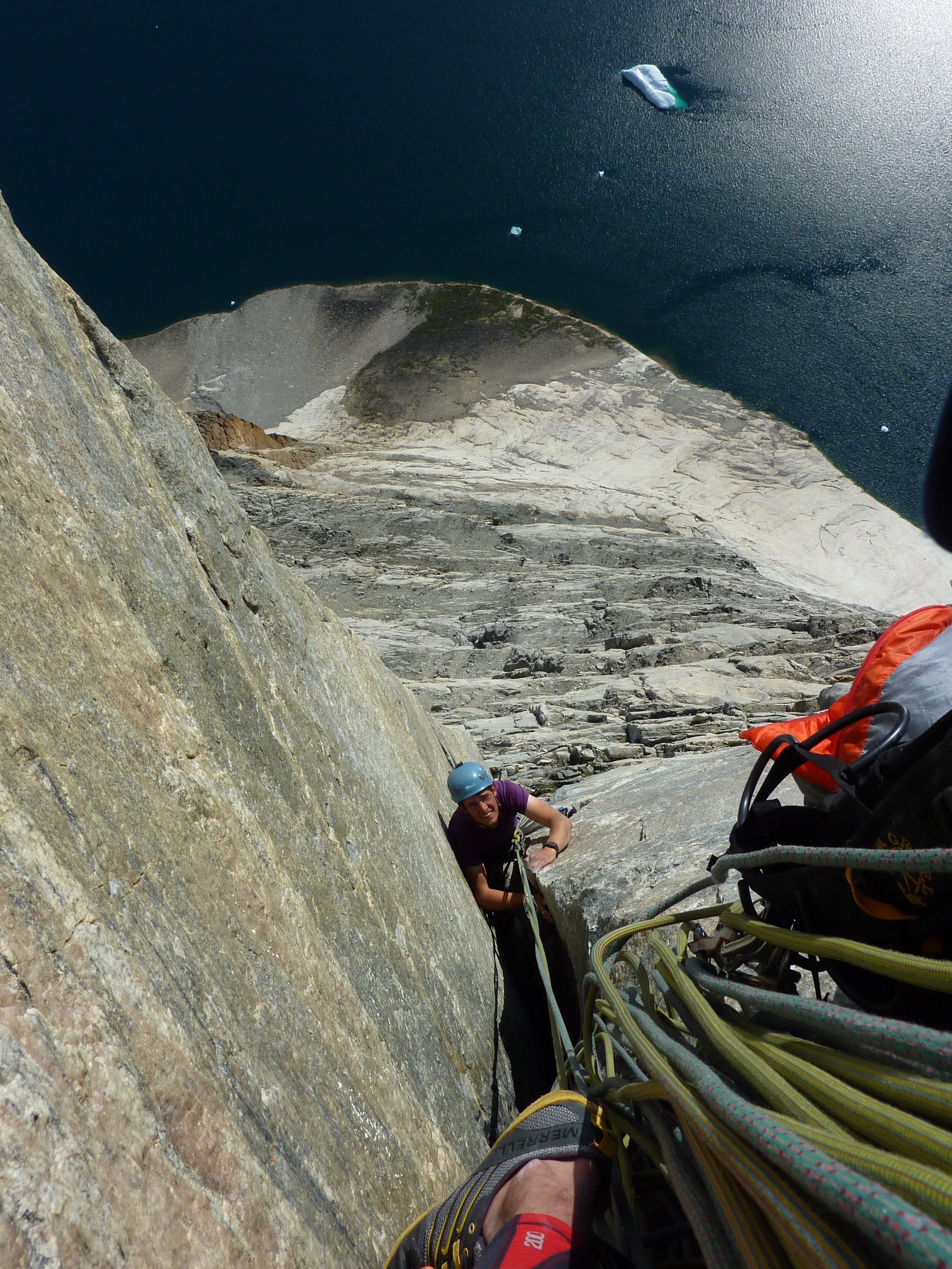The Horn of Upernavik
Upon arriving in Greenland, Ian and I spent a week sat on the dock in Illulisat waiting for our boat, the "Cosmic Dancer" to show up. Our friends Tom, Peter and sailors Clive and Angela had sailed the boat across the Labrador sea from Canada. Due to some small, pesky things like force 9 gales, they were delayed. We invented some jokes:
"Knock Knock"
"Who's there?"
"Not the Cosmic Dancer!"
After a week, the boat got to within five miles of us, only to be forced to turn back! Too many ice bergs had blown into the harbour and had effectively blocked it off. Ian and I decided some drastic measures were in order, we hitched a ride with some cowboy seal hunters. They drove at 40 miles an hour through the fog, dodging icebergs and laughing. Then me and Ian were left cowering in the front of their boat whilst they shot over our heads at seals!
The "Horn of Upernavik" was our first objective, the 1200m main face had never been climbed despite recent attempts by several expeditions. It turned out to be a pretty life changing adventure for me. Here is a piece of writing telling the story. I wrote it whilst still recovering from the ordeal so it gets quite dramatic in places:
Finally all aboard the Cosmic Dancer we motored through the fog towards the Horn with only the occasional iceberg appearing to keep us company. We’d been planning to try and climb the Horn of Upernivik for nearly a year but to me it still sounded a bit like somewhere out of Lord of the Rings, not like somewhere you could actually go. As we turned the corner into the fjord the fog lifted to reveal a thin strip of sea bounded either side by huge sheer walls of deep red and black granite. This was to be our home for the next 8 days or so. I found the fjord quite a spooky place to be, with a kind of silence I don’t think exists in England. Only punctured by the occasional rolling boom – you could never quite tell if it was caused by avalanche, rock fall, an iceberg collapsing or thunder.
The Horn itself looked different to the other mountains. Rather than the deep red looser rock, it presented a curving arc of golden granite that glowed in the sun. It was hard to get a sense of scale. It wasn’t until a few days later when I saw my friends as tiny orange specs halfway up that it really sunk in just how big this wall really was. 1200 metres high, taller than the highest faces in Yosemite and the height of several Verdon Gorges stacked one above the other.
The slab and upper headwall had been attempted at least 3 times by expeditions in the last few years but none had succeeded. The closest was an attempt by British climbers George Ullrich and Matt Burdekin in 2010 who got within a few pitches of success in a single alpine style push only to be forced to retreat due to reaching an impasse in the headwall and running out of food and water.
Ian and I decided to try their line for at least the first 600m or so and to try another crack system in the upper headwall. However, fearing that the same problem might befall us if we tried it in a single push, we decided to spend a day or two fixing ropes as high as we could up the lower slab and returning to base camp each day. So that we could quickly ascend these when we did go for a summit push. The 24 hour daylight meant we weren’t limited by light in how long a push could be, only by how tired we might become.
Day 1. We spent the day with me leading and fixing ropes. Ian followed jumaring in his trainers with a literally enormous bag on his back (that I don’t think I could actually lift) containing about 300m of ropes and enough water for a small fire engine. As supposedly the better technical climber the leading was my responsibility, I couldn't help feeling that Ian got a raw deal here, but he seemed stoically content with this arrangement. The first pitch gave an indication of the nature of the climbing ahead. Good solid granite with apparently no gear. Damn. I took out my nutkey and started gardening, finding that there was in fact plenty of gear underneath clumps of earth which filled the cracks. By the end of the first pitch my nutkey was worn sharp to a point. Not a good start.
The guys who tried the same line in 2010 warned that the second pitch could well be the crux of the whole route. Sure enough the crack closed up completely leaving 30m of blank slab with only the smallest of ripples giving footholds. Ullrich had hand placed a bolt in the centre of the pitch whilst on lead. This provided the only meaningful protection. Full credit to him for this, the thought of standing precariously in the middle of that pitch for half an hour whilst hand drilling a bolt makes me shiver and I’m not sure I would have been able to do it. I set off with some trepidation and managed to find a sideways rock 2 five meters up, which might have kept me from falling directly onto Ian’s belay. Small downward pointing overlaps provided the only hand holds and sketchy smears gave enough purchase to continue rocking over and reach the bolt. Clip, thanks George. From here the climbing got hard. As the bolt got further and further beneath me, thoughts of how far away from any help I was began to surface in my mind and cloud my concentration. I was on the pitch for a long time, contemplating attempting to reverse or jumping off and taking the long, skittering whipper onto the bolt. It seemed like every time I finally came to the conclusion that it was too dangerous and I should retreat, I would spot a new ripple in the slab which would lure me one rock over further from safety. The pitch was probably stupidly dangerous and I actually have no idea why I committed to it. Somehow I arrived at the belay and spent the next five minutes yelling wordlessly at the top of my lungs as the tension left my body and I allowed the adrenalin to kick in. George said that even with the bolt the pitch was E5 6a “if not a touch harder” I think what he meant here was E6!
That day we managed to fix 250m up the slab before returning to base camp.
Day 2. We aimed to get halfway up the face to some “scree filled ledges” that Matt Burdekin had mentioned in his report, bivvy here, then go for a summit push the next day. We got another 3 pitches up the slab from the top of our fixed ropes to reach a broken ledgy section beneath some overlaps.
Still a good 200m below the ledges we had hoped to bivvy on. Ian was jumaring with the both bags (cheers Ian!) up a particularly nasty E4 5cish runout slab pitch. I heard an ominous buzzing noise above me followed by a sharp crack. Rocks started to rain from the sky. Big blocks fell to either side of me, any one of which big enough to kill a person. Ian frantically jugged the remaining 10m and we made a belay under an overlap for shelter. I was truly terrified. A kind of dull, hollow fear. Very different to the intense invigorating fear I had experienced on the lower crux pitch. I feel like I now have some idea of what it must be like being shot at, the randomness of it felt somewhat comparable. Five minutes later a 4 slice toaster size block landed exactly where I had been sat and shattered, leaving a cloud of dust and a dry acrid smell in the air. It seemed Peter and Tom who had been on the wall above us for about 36 hours had got bored on their descent and resorted to trundling rocks at us! They were at this point descending from their new route “Choss, the Universe and Everything”, up the more broken right hand wall, E2/XS 5c 1200m (nutters!). We waited for 2 hours beneath the overlap until our next appointed time to speak with Tom and Pete on the walky-talky. We told them to “not move!” and abbed back to the floor leaving another 120m of fixed lines on the harder sections we had climbed that day.
Day 3. Summit push. We decided to just go all out for the summit in a single push since we now had fixed ropes about a third of the way. Also this way we could travel much lighter, move faster and Ian could finally put his rock shoes on and do some climbing!
The sun had been blazing for 4 days so we decided to jumar at 2pm in the sun in order to reach the end of our fixed lines as the face went into the shade. This way we could climb through the cooler temperatures of the night and we would need to carry less water. Jugging 400m of slab in the sun was miserable to say the least! But after this we made good progress and by 2am we had covered a further 500m of ground, tavelling light and swinging leads. The climbing was never desperate but in some places it was extremely runout, probably up to about E4 5c. However as we climbed ominous clouds started to gather on the surrounding mountains and I became increasingly worried that a storm was brewing.
At 3am, maybe 200m from the top it seemed our weather window had closed as rain set in around us and the temperature dropped. Facing the prospect of a slippery 900m abseil descent, I was pretty scared at this point. Especially as if clouds moved in below us it would make navigating back to our fixed ropes extremely difficult. But being halfway up the headwall we were so close to completing our route that we decided to try and wait out the rain and see if we could press on for the top. We crawled under a fallen block which gave nearly enough room for the two of us to lie flat side by side, both still attached to the belay with slings.
The phrase “shiver bivvy” is definitely appropriate for this one! We were supposed to be going “fast and light” so we didn’t have enough clothes. We got out a silver foil type space blanket from our first aid kit and shared it. 4 hours later at 7am Ian was showing signs of being a bit uncomfortable, the prince biscuits were finished and the rain seemed to be stopping. We pressed on up the headwall trying a line about 50m to the left of the crack which repelled Ullrich and Burdekin 3 years ago. We got to the base of the most immaculate dihedral running up the final 100m. The granite looked so good it almost made the effort to get there worthwhile! The only problem was the lovely hand crack we had spotted from base camp wasn’t a hand crack at all… but a squeeze chimney! I really had to give these last two pitches everything, Ian later told me I sounded like I was giving birth, whilst I literally squirmed for my life. Not pretty.
We reached the top by 1pm, 23 hours after setting off, feeling pretty strung out, extremely proud to have made it and nervous about the descent.
We decided to try and follow Tom and Peter’s descent line down the choss and scree ledges to the right. As this would mean leaving behind less gear, plus, if we could find their ab tat we could hopefully get down relatively fast...
What followed was 7 hours of terrifying scrambling around on sloping scree ledges. As we descended the rain set in again and the weather window was firmly slammed and bolted from the inside. Any later and we wouldn’t have made it as the rain continued non-stop for 48 hours!
30 hours after setting off we hobbled back into camp.
The route took every ounce of strength, courage, intuition and luck that I had at my disposal and left me totally exhausted. It felt like every skill I have developed as a trad climber so far was tested and put to use.
Cosmic Rave – E6 6a – 1225m
I am both very proud of the line and very glad to be down. I wouldn’t go back up that mountain if you paid me!
When the rain finally stopped Tom and Peter kindly offered to go up and get the fixed ropes down. I was more than happy to offer helpful hints for them over the radio from base camp. It turns out every single rope we have was trashed by rock fall during the rain. Tom and Peter bravely jugged up and retrieved the trashed ropes which we later cut down to size. Instead of 6 60m ropes and 100m of static rope, we now had 55m, 52m and 51m ropes plus loads of ab tat! Wall rope anyone?
Luckily we met up with the Irish climbing expedition in the village of Uumanaq a few days later. They took pity on us, prized open a barrel labelled “fulmar most foul” and sold us some non-trashed ropes on the cheap. The only minor downside being the nauseating smell of fulmar vomit. Win!










